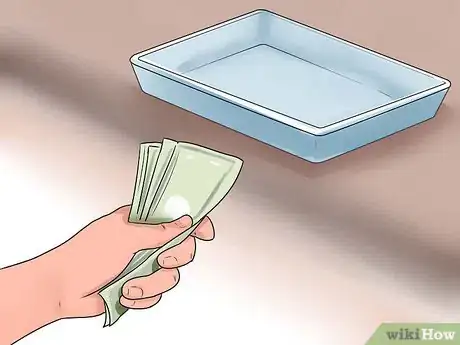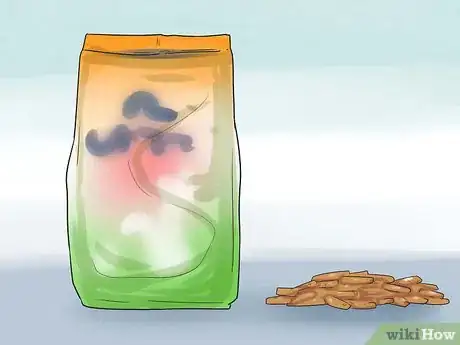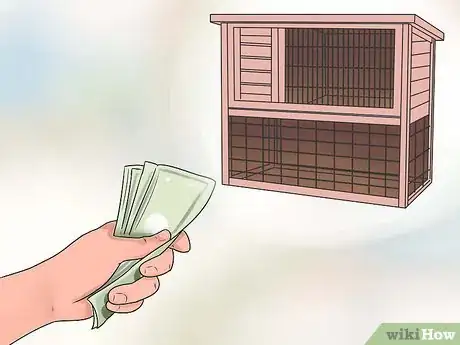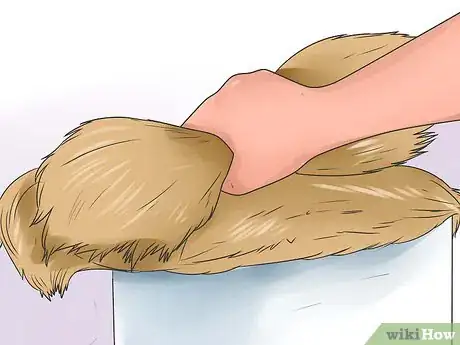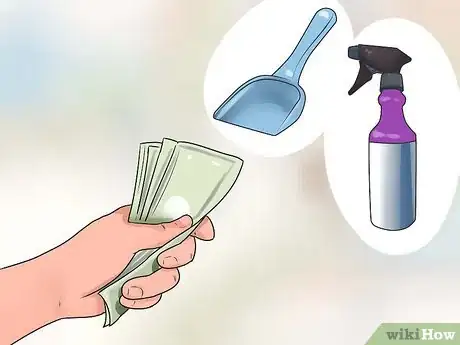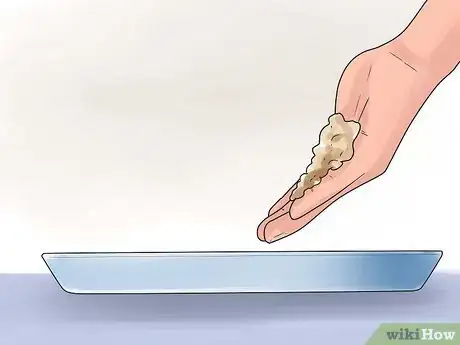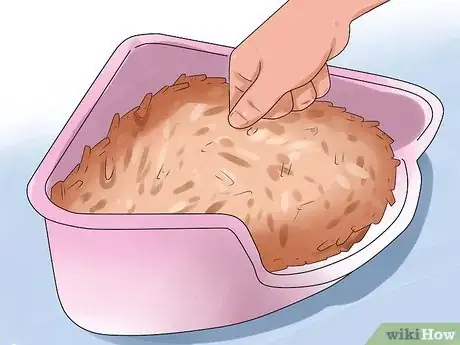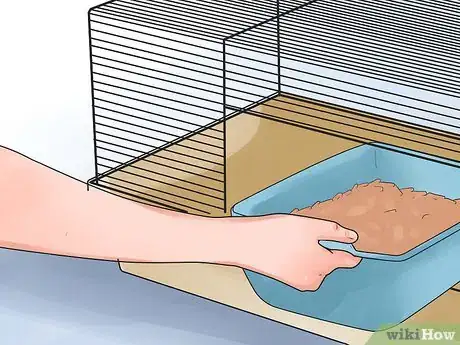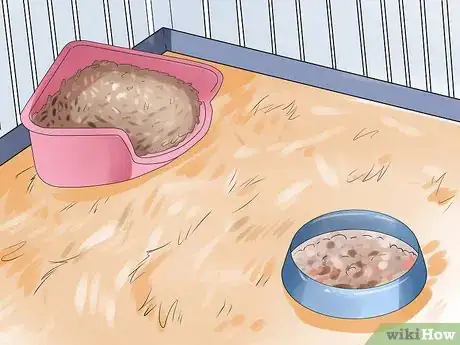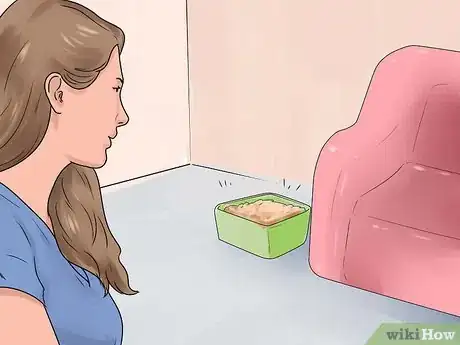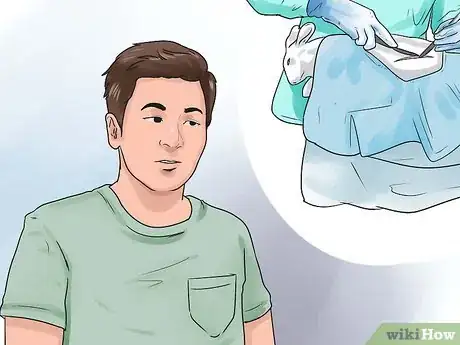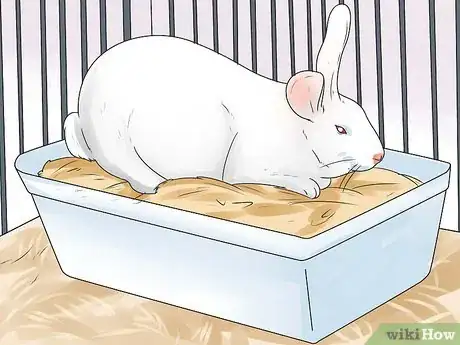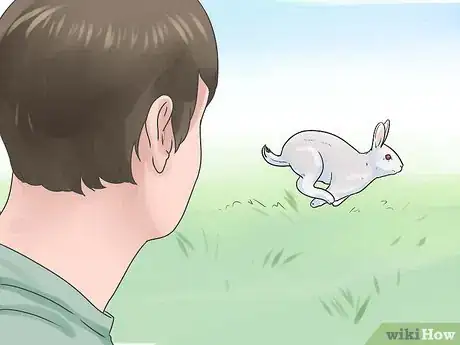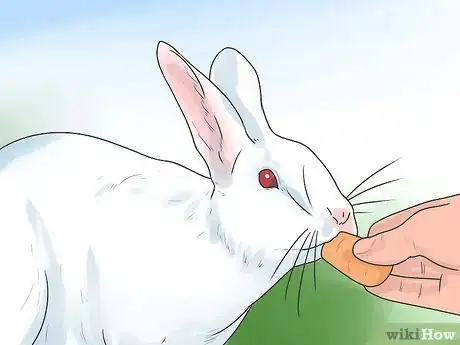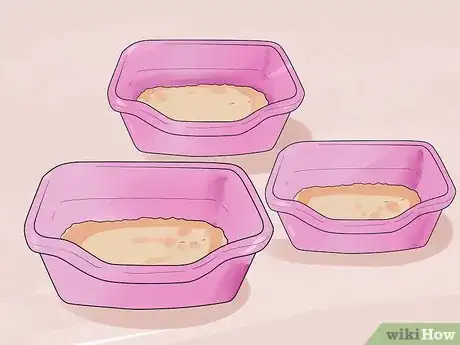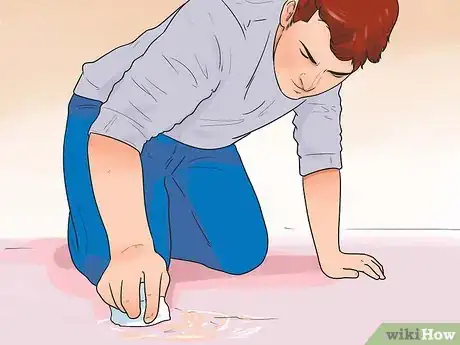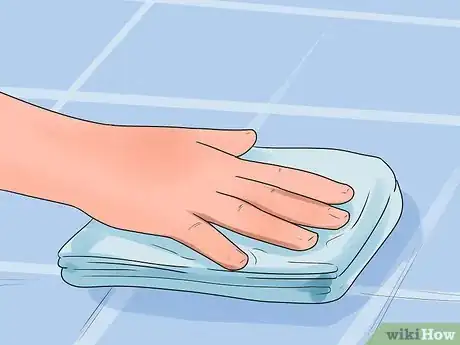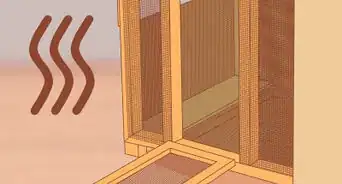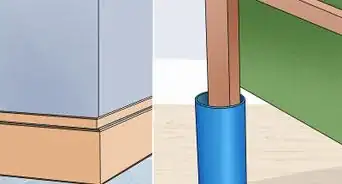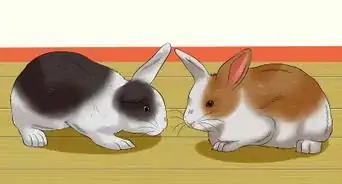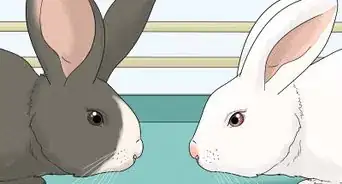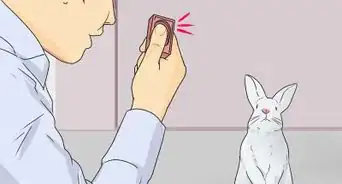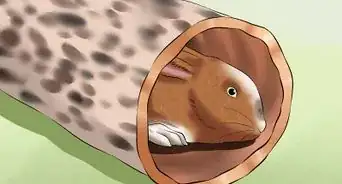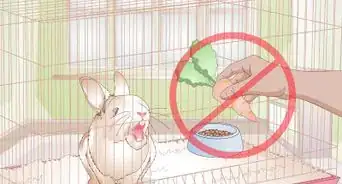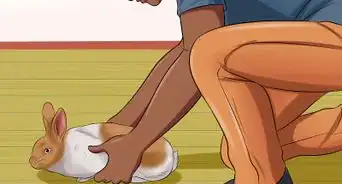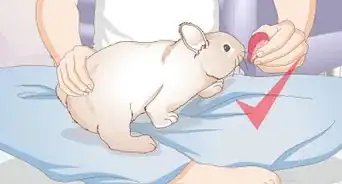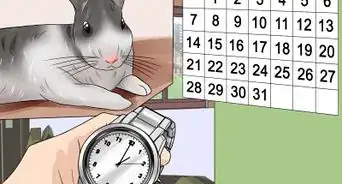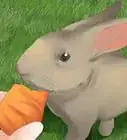This article was co-authored by Pippa Elliott, MRCVS. Dr. Elliott, BVMS, MRCVS is a veterinarian with over 30 years of experience in veterinary surgery and companion animal practice. She graduated from the University of Glasgow in 1987 with a degree in veterinary medicine and surgery. She has worked at the same animal clinic in her hometown for over 20 years.
wikiHow marks an article as reader-approved once it receives enough positive feedback. This article received 15 testimonials and 92% of readers who voted found it helpful, earning it our reader-approved status.
This article has been viewed 1,063,533 times.
Want to let your new rabbit hop around the house, but are worried about finding little pellets everywhere? Don't worry. Rabbits are naturally clean animals, and training a rabbit to use a litter tray is not as difficult as you might think. Just gather your supplies, set up the litter tray, and train your rabbit to use it. It comes easily to most rabbits. In fact, most adult, desexed rabbits will pick one spot to urinate and defecate, so in most cases all you need to do is put a litter box there.
Steps
Gathering Supplies
-
1Purchase a litter pan. Litter pans/trays/boxes designed for rabbits have a raised back (to prevent litter flying everywhere when they scrape) and a low front (to make it easier for the rabbit to hop in).[1] You may want to purchase several pans or trays so that you can eventually disperse them around the house and easily swap them out when cleaning and disinfecting the litter pans.
- You don't have to use a special rabbit tray. A regular cat litter tray with lower sides is fine, or even a shallow cardboard box (but be prepared to replace it regularly as it will get chewed).
-
2Have newspaper handy. Use it to line the bottom of the tray, which will make it easier to clean the pan out.[2]
- Most newspapers now use soy-based ink, which is not toxic for rabbits, but always check before using it. Newspaper ink can also rub off onto your rabbit's coat, turning it black or gray.
Advertisement -
3Get the right litter. Choose a rabbit-safe product, such as paper-based litter or untreated aspen chips. Don't use pine or cedar chips, since these are treated with oils that can irritate a rabbit's lungs.[3]
- Do not use clay based cat litters or clumping cat litters. If the rabbit eats them, these litters could cause a bowel blockage.
-
4Buy a cage. The cage should be three to six times the length of the rabbit. The first step of training is to restrict your rabbit to a cage with food, water and a hide in one half, and the litter tray in the other. The restricted space encourages your rabbit to not soil her living area, and toilet in the tray.[4]
-
5Get good quality hay. Use hay to attract the rabbit to the litter box.[5] Rabbits frequently like to munch on a snack while toileting, so this will encourage her to use the space.
-
6Purchase a litter scoop and disinfectant. You will scoop out litter soiled with urine on a daily basis. The whole tray needs disinfecting at least once a week.[6] Use a commercial disinfectant designed specifically for small animals.
Setting up the Litter Tray and Cage
-
1Place a few pellets in the tray. Collect up some of the rabbit's pellets and drop them into the tray.
-
2Prepare the litter box. Line the bottom of the litter tray with a sheet of folded up newspaper. Cover the newspaper with approximately one inch of litter. Rabbits do not bury the litter tray. This places some of the rabbit's scent in the box which gives her the idea it's the right place to toilet.[7]
-
3Set up the litter box in the cage. Place the litter tray at one end of the cage and scatter some fresh hay in the tray, or attach a rabbit hay rack to the end of the cage where the tray is located. Rabbits like to eat as they toilet, so some tasty hay will attract her attention and encourage her over.[8]
-
4Set up a bedding and food station in the cage. Put bedding at the other side of the cage and set up her food, water, and a hide.[9] This will give her somewhere to hide and feel secure.
-
5Place litter boxes in other areas of the house. Put out several boxes in areas your rabbit spends time or exercises in. The more litter boxes you have, the more likely it is the rabbit will use one of them.
- Before introducing your bunny to the litter box for the first time, watch it and pay attention to where it does its business. Typically, it will be the back corner. Once you've established your bunny's preferred area, place a box in that spot.
Training Your Rabbit
-
1Begin training your new rabbit as soon as you bring her home. Adult rabbits learn more quickly than immature rabbits (under 4 months of age). However, it's never too early to start litter training. Make a tray available as soon as you bring a new rabbit home, and start to teach her how to use it. Just be patient and she will eventually learn.[10]
- Most desexed adult rabbits will defecate and urinate in one corner, so you only need to place their litter box in their toilet corner.
- Starting out, when she toilets outside the litter tray, scoop up the pellets and put them in the tray as a hint as to where to go.
-
2Consider spaying or neutering your rabbit. Un-neutered adult rabbits are more territorial and they use their scent to claim space. This involves depositing urine and pellets around the house, using scent as a territory marker. Getting your rabbit neutered will make it much easier to litter train her, because her need to be territorial is vastly reduced.[11]
-
3Teach your rabbit to use the litter box in her cage. At first, it helps to restrict the rabbit to the cage with the tray, so that the rabbit learns not to soil the eating and sleeping area. It only takes a couple of days to teach— once the rabbit understands this, you can start letting the rabbit out.
-
4Let your rabbit out of her cage for brief periods of time. When you allow her out to exercise, if she squats to the toilet, gently pick her up and place her in the litter box that's in her cage. A sign the rabbit is about to eliminate is that she raises her tail in the air slightly. You need to be vigilant for this, but it does help if you can catch her in time.[12]
- In the early stages of training, do not let her out for more than ten minutes at a time, and do not leave her unsupervised in a room (you want to catch her before she toilets). Once she is using a tray regularly, you can relax your vigilance and let her have more freedom.
-
5Congratulate your rabbit for using the litter box. Never shout or get angry with your rabbit if she doesn't use one of her litter boxes. Rabbits don't learn this way. Positive reinforcement is a much better teacher.
- Offer a little treat, such as a bite of apple or carrot, immediately after she uses her litter box. This will reinforce a positive connection between toileting and the box.
-
6Adjust the number of litter boxes. Once your rabbit starts using litter trays reliably, you can alter the number or position of them as needed.
- For example, if your rabbit only uses two litter boxes and ignores the others, the extras can be removed. If your rabbit ignores one litter box, but urinates in a corner three feet away, move the litter box to the corner.
Cleaning the Tray and Dealing with Accidents
-
1Spot clean the tray. Once a day, scoop out litter soiled with urine. It's fine to leave pellets behind for a day or so as they act as scent markers for the rabbit to go back to.[13]
-
2Don't remove all of the pellets from a dirty tray. When cleaning the litter tray, keep an eye out for large, moist looking pellets, which are made up of half-digested food. Leave them in the tray for the rabbit to re-eat and get vital nutrients. Without these pellets, your rabbit could suffer from gastric disturbances and diarrhea, and in the long term, dietary deficiencies.[14]
-
3Completely clean the litter box. Once a week, completely empty the tray and clean it. Simply dump the entire contents into a plastic bag, tie it off well, and throw it in the trash. Clean the tray with a disinfectant, rinse well, and allow to dry. Then remake the tray with newspaper and litter.[15]
- Vet clinics or pet stores sell disinfectants that are safe for use around pets.
-
4Clean up after any accidents. Accept the accident for what it is, and then clean the area well so she doesn't continue to toilet in the wrong place. Use a solution of biological washing powder and work it in well with a clean cloth or sponge. Then rinse with clean water.[16]
- Do not yell at or punish your rabbit. Rabbits do not learn anything through punishment, other than to be fearful of the person doing the chastising.
- When getting rid of a mess, always test the carpet for colorfastness first.
-
5Get rid of any lingering smells. Work a solution of baking soda into the carpet, then rinse with clean water. If the surface is smooth, such as tiles or lino, finish by wiping it over with surgical spirit.[17]
- Do not use cleaning products that contain bleach. It contains ammonia, a component of urine, and can actually strengthen the smell of urine.
Expert Q&A
Did you know you can get premium answers for this article?
Unlock premium answers by supporting wikiHow
-
QuestionCan a rabbit be trained to use a litter box?
 Pippa Elliott, MRCVSDr. Elliott, BVMS, MRCVS is a veterinarian with over 30 years of experience in veterinary surgery and companion animal practice. She graduated from the University of Glasgow in 1987 with a degree in veterinary medicine and surgery. She has worked at the same animal clinic in her hometown for over 20 years.
Pippa Elliott, MRCVSDr. Elliott, BVMS, MRCVS is a veterinarian with over 30 years of experience in veterinary surgery and companion animal practice. She graduated from the University of Glasgow in 1987 with a degree in veterinary medicine and surgery. She has worked at the same animal clinic in her hometown for over 20 years.
Veterinarian
-
QuestionHow do I train my rabbit to come to me?
 Pippa Elliott, MRCVSDr. Elliott, BVMS, MRCVS is a veterinarian with over 30 years of experience in veterinary surgery and companion animal practice. She graduated from the University of Glasgow in 1987 with a degree in veterinary medicine and surgery. She has worked at the same animal clinic in her hometown for over 20 years.
Pippa Elliott, MRCVSDr. Elliott, BVMS, MRCVS is a veterinarian with over 30 years of experience in veterinary surgery and companion animal practice. She graduated from the University of Glasgow in 1987 with a degree in veterinary medicine and surgery. She has worked at the same animal clinic in her hometown for over 20 years.
Veterinarian
-
QuestionWhat is the best litter to use for rabbits?
 Pippa Elliott, MRCVSDr. Elliott, BVMS, MRCVS is a veterinarian with over 30 years of experience in veterinary surgery and companion animal practice. She graduated from the University of Glasgow in 1987 with a degree in veterinary medicine and surgery. She has worked at the same animal clinic in her hometown for over 20 years.
Pippa Elliott, MRCVSDr. Elliott, BVMS, MRCVS is a veterinarian with over 30 years of experience in veterinary surgery and companion animal practice. She graduated from the University of Glasgow in 1987 with a degree in veterinary medicine and surgery. She has worked at the same animal clinic in her hometown for over 20 years.
Veterinarian
Warnings
- Stay away from softwood, corncob, clay, and clumping litters. Aromatic softwood litters made from pine or cedar emit gasses that cause liver and respiratory tract damage. This can lead to chronic asthma and respiratory disease and lessen your rabbit's ability to handle standard rabbit medications.
- Inhaled dust from clay litter can irritate a rabbit's nose and eyes and can form clumps in the rabbit's lungs making the rabbit more vulnerable to respiratory problems. If a rabbit ingests clumping or corncob litter, it can form a solid mass in the rabbit's digestive system that causes shutdown and is often fatal.
- Even if you don't see your rabbit eating the litter, don't assume it is safe. Rabbits are meticulous groomers and your rabbit will ingest litter particles that are clinging to his fur.[18]
⧼thumbs_response⧽
References
- ↑ Why Does My Rabbit..? Anne McBride. Publisher:Souvenir Press
- ↑ Why Does My Rabbit..? Anne McBride. Publisher:Souvenir Press
- ↑ Why Does My Rabbit..? Anne McBride. Publisher:Souvenir Press
- ↑ Why Does My Rabbit..? Anne McBride. Publisher:Souvenir Press
- ↑ Why Does My Rabbit..? Anne McBride. Publisher:Souvenir Press
- ↑ Why Does My Rabbit..? Anne McBride. Publisher:Souvenir Press
- ↑ Why Does My Rabbit..? Anne McBride. Publisher:Souvenir Press
- ↑ Why Does My Rabbit..? Anne McBride. Publisher:Souvenir Press
- ↑ Why Does My Rabbit..? Anne McBride. Publisher:Souvenir Press
- ↑ The Handbook of Rodent and Rabbit Medicine. Laber-Laird, Swindle, & Flecknell. Publisher: Pergamon
- ↑ BSAVA Manual of Rabbit Medicine. Meredith and Lord. Publisher: BSAVA publications.
- ↑ Why Does My Rabbit..? Anne McBride. Publisher:Souvenir Press
- ↑ BSAVA Manual of Rabbit Medicine. Meredith and Lord. Publisher: BSAVA publications.
- ↑ The Handbook of Rodent and Rabbit Medicine. Laber-Laird, Swindle, & Flecknell. Publisher: Pergamon
- ↑ BSAVA Manual of Rabbit Medicine. Meredith and Lord. Publisher: BSAVA publications.
- ↑ BSAVA Manual of Rabbit Medicine. Meredith and Lord. Publisher: BSAVA publications.
- ↑ BSAVA Manual of Rabbit Medicine. Meredith and Lord. Publisher: BSAVA publications.
- ↑ http://www.rabbit.org/journal/1/liver-disease.html
- http://www.rabbit.org/
About This Article
If you want to litter train a rabbit, line a litter tray with newspaper, then fill it with a rabbit-safe litter made from paper or aspen. Do not use clay or clumping cat litters. Keep your rabbit in a large cage, with its food, water, and hiding spot on one side of the cage and the litter tray on the other. Place good quality hay near the litter tray to encourage the rabbit to go to that area. Clean the litter daily, and disinfect the entire litter box at least once a week. Keep reading for tips from our veterinary reviewer on how to get your rabbit to use a litter box outside of its cage!
